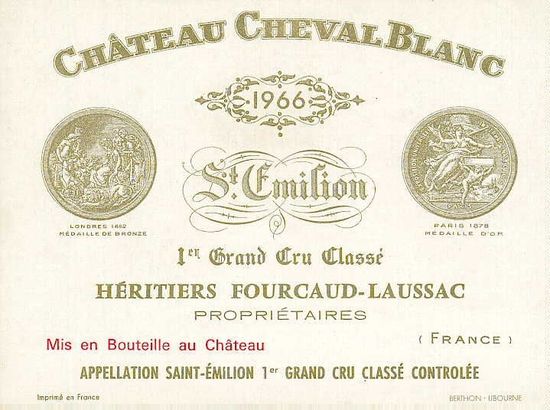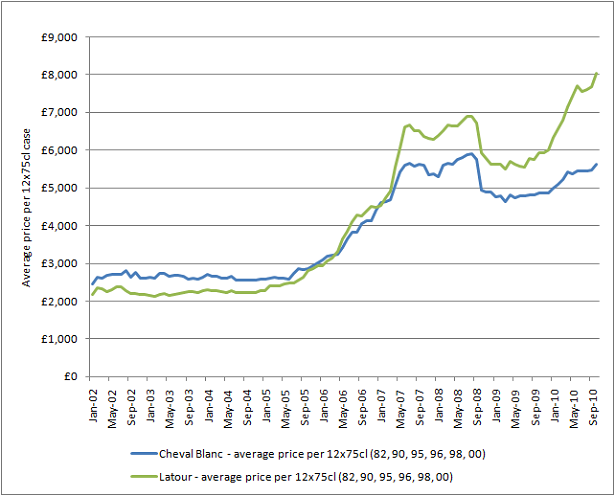Owner: LVMH and Albert Frere
Classification: St Emilion Grand Cru Classe A
Vineyard area: 37 hectares
Average annual production: 72,000 bottles p/a
Colour: Red
Standard blend: 45% Merlot and 55% Cabernet Franc
Second Wine: Petit Cheval (30,000 bottles p/a)
History
An earmark of its superlative quality, Cheval Blanc is one of just two estates to have been designated the illustrious rank of Grand Cru Classe A in St Emilion’s 1955 classification (the other being Chateau Ausone). The iconic estate is relatively young by Bordeaux standards, as the vineyards originally formed part of Figeac and were only acquired by the Ducasse family in 1832. More vineyards were purchased in the years that followed and the burgeoning property passed to Jean Laussac-Fourcaud and his family in 1852 as part of Henriette Ducasse’s dowry. The estate flourished under their hand, partly as a result of the network of flood-repellent field drains that were installed (a great innovation at the time). For some years, however, the owners were reluctant to cut all ties with neighbouring Figeac, and the wine continued to be sold under its label. But when the family finally began marketing their wine independently, its superior quality garnered high esteem, winning medals at the London and Paris International Exhibitions in 1862 and 1867. (These are still displayed on the label today).
Despite the battery of phylloxera and war, the Laussac-Fourcaud family (later reversed to Fourcaud-Laussac) held tenure at Cheval Blanc for over 150 years, thereby avoiding the deterioration in quality that tends to accompany perpetual changes in ownership. In 1998, their dynasty came to an end when the chateau was jointly purchased by luxury goods group LVMH (the owners of Yquem) and Belgian businessman Albert Frere. Since the takeover, quality has been well maintained – possibly even heightened. Unfortunately, however, prices have risen sharply, thus weakening the brand’s overall power in the marketplace.
The 2009 vintage
A blend of 40% Cabernet Franc and 60% Merlot (a rarity given the usual dominance of Cabernet Franc), Cheval Blanc 2009 received 18.5 out of 20 points from Jancis Robinson – “really quite subtle”, and 98 from James Molesworth on Wine Spectator , who described it as “dense, brooding and richly coated.” In spite of its critical acclaim, the 2009 has inspired rather subdued activity on the exchange – largely due its intimidating London release price (£7,750 per case).
Market trends
Although Cheval Blanc has, historically, been more expensive than the Medoc First Growths, in recent years the tables have turned. If we take Latour as a benchmark – the most expensive of the Premier Crus until the recent Lafite surge – we can see that Cheval is now significantly cheaper. The chart below (which tracks the average prices of leading older vintages from both chateaux) shows that the First Growth has decisively outperformed Cheval Blanc since 2007. Whereas the former continues to hit new price highs, Cheval is currently cheaper than it was prior to the 2008 price fall.
Why the change? Like most Right Banks, Cheval Blanc has yet to take off in Asia. But as can be seen in the graph above, the switch happened before the start of the “Asian phenomenon”, so other factors are clearly at play – most notably, pricing.
Prior to 2007, vintages of Cheval Blanc had always been released a touch above those of its First Growth rival. And though the stellar 2005 vintage saw all of the major Bordeaux brands emerge at new price highs, it was the release of the 2006 that really saw Cheval Blanc attempt to reposition itself. At €480 per bottle (ex-negociant), the vintage was released 48% above the price of Latour (€325 p/b) – despite bearing the same 95-point score from James Suckling. Since then, successive Cheval Blanc vintages have reflected the same ambition, with the 2008 in particular coming to market at more than double the price of Latour.
As a result of these sharp increases, the last four vintages of Cheval Blanc have seen very little price movement since their London release, thus impairing demand for the brand as a whole. (The 2006 and 2007 have actually moved downwards in price.) By contrast, vintages of Latour have experienced remarkable price appreciation, with the 2006, 2007 and 2008 all increasing in value by more than 40% since release. Because of this, recent vintages of the First Growth (2006-2009) are, on average, 60% more expensive than those of Cheval Blanc.
Although Cheval’s hapless rebranding exercise has diminished its power in the marketplace, a number of older vintages still represent extraordinary value for money. The 1999, 2001, 2002 and 2004, for example, are all currently available at £2,500 and under (and have already spent a number of years in bottle). The 1995 and 1996 have also excited buyer’s attention this month, having last traded on Liv-ex at £2,850 and £2,650 respectively. At around a third of the price of the 2009, both vintages seem to be solid buys.







